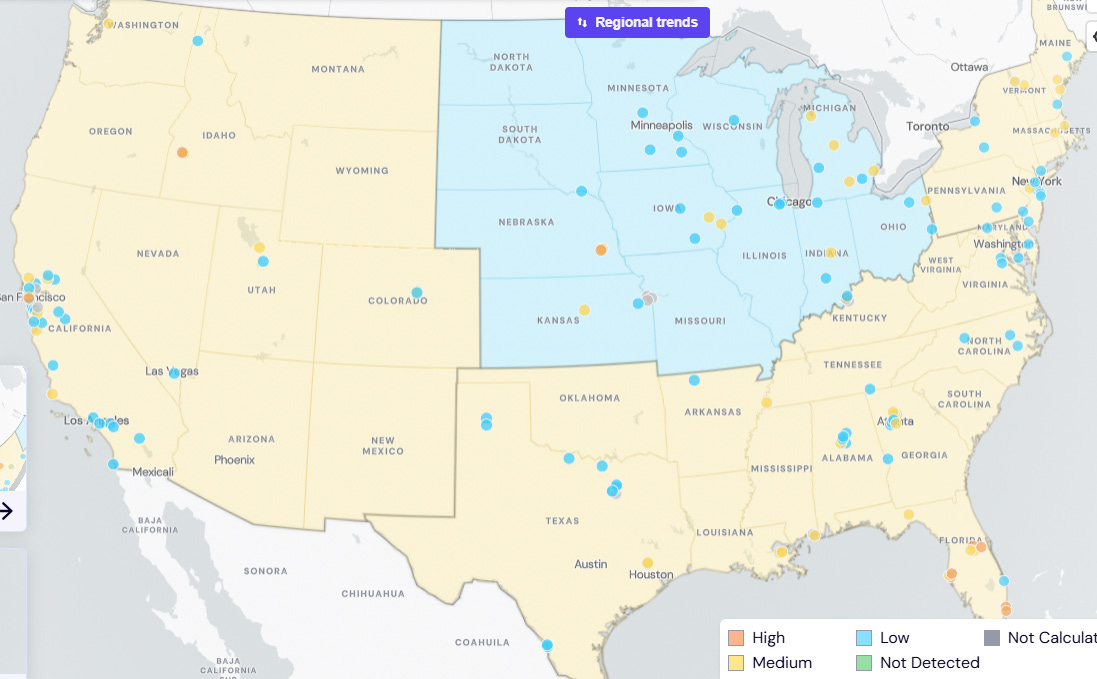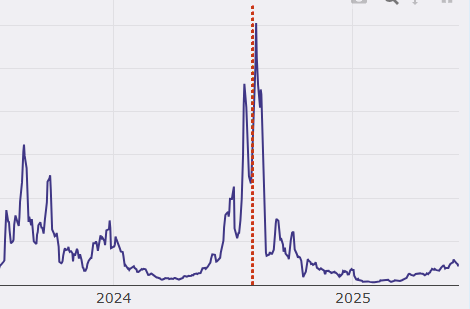COVID Emergency Department visits are still low, and deaths from COVID are low at this time as well. As of June 20, according to JP Weiland, there are 169,000 new COVID infections per day in the United States, with about 1 in every 200 people currently infected. He notes a slight increase in COVID cases this week as new variants XFG and NB.1.8.1 (Nimbus) increase. JP Weiland expects that “Southern and Western states should bear the brunt of case increases, as there was effectively no winter wave in large swaths of either region. Midwest and Northeast [regions] will be more resistant.”
According to Michael Hoerger, “the CDC website did not update properly today [June 20, 2025]. The national [COVID wastewater] levels did not appear correctly on their main page but can be found readily on their individual state level pages, as a comparison to state and region level data.” He also stated that “The CDC wastewater surveillance system has COVlD transmission up 8% relative to last week's report. This is the largest increase since the 1st week of January.” WastewaterSCAN shows medium levels of SARS-CoV-2 in wastewater in most regions except the Midwest.
In California, data from the California Department of Public Health (CDPH) shows that central California is in the high range for COVID, with medium levels in the Bay Area and low levels in Southern California. However, per WastewaterSCAN, Oceanside San Francisco is highest in the state at 272 PMMoV, Fremont is 221 PMMoV, San Jose has decreased to 133 PMMoV, Santa Rosa is 125 and Davis is 114 PMMoV. Santa Clara County considers the San Jose watershed to be high for COVID, although it is decreasing, Palo Alto is medium and Sunnyvale and Gilroy are at low levels of SARS-CoV-2 in wastewater.
SARS-CoV-2 Variants
The CDC stated that they are no longer going to report COVID variant levels every 2 weeks due to low numbers of sequences being reported. The CDC did not update the variant levels yesterday. The main variants reported two weeks ago were NB.1.8.1 (Nimbus) and XFG.
Acute COVID infections, General COVID info
A new study of 35,525 adults finds that giving low-dose aspirin during acute COVID infection may lower the risk of developing type 2 diabetes by 52%. The benefit may come from aspirin’s ability to reduce inflammation and blood clotting triggered by SARS-CoV-2.
In a prospective ICU cohort, 41% of COVID patients experienced Cytomegalovirus (CMV) reactivation, and 9% developed clinically significant CMV disease. In ICU patients without COVID infection, only 20.7% had CMV reactivation and 1.2% became ill with CMV. High-dose steroid use was noted to be a major risk factor for CMV reactivation.
Vaccines
All former Advisory Committee on Immunization Practices (ACIP) members co-authored an important letter warning about the abrupt dismissal of the entire 17-member panel by the current administration. Only eight new members have been appointed so far, raising fears about diminished expertise and continuity. Experts warn that this move threatens to destabilize evidence-based vaccine policy, reduce access to critical immunizations, and damage public trust in national vaccination programs.
Antiviral treatments
A large pooled analysis of hospitalized COVID patients from the ACTIV-3/TICO trials (n = 2,254) found that while neutralizing monoclonal antibodies (nMAbs) boosted anti-spike levels at 28 and 90 days, they did not diminish the natural anti-nucleocapsid antibody response compared to placebo. This suggests that nMAb treatment does not interfere with the body’s own long-term antibody immune response.
Long COVID
A new comprehensive review on neuroimmune pathophysiology of Long COVID by Iwasaki and colleagues explores how SARS-CoV-2 can cause lasting neurological symptoms through a combination of direct infection, immune dysregulation, and persistent inflammation. Key mechanisms include viral antigen persistence, autoimmunity, blood–brain barrier disruption, neurotransmitter imbalances, and glial cell dysfunction. The authors link these processes to cognitive impairment, fatigue, dysautonomia, and other Long COVID symptoms.
The authors state, “Despite the perception that COVID-19 is now a mild disease, there is overwhelming evidence indicating that SARS-CoV-2 infection is capable of producing widespread post-acute sequelae in a significant percentage of infections. This includes a substantial impact on the nervous system resulting from a combination of direct infection, systemic inflammation, immune dysfunction, vascular complications, and tissue hypoxia.”
Figure 1: Systemic neuroimmune manifestations of Long COVID in reviewed studies
From: https://onlinelibrary.wiley.com/doi/10.1111/pcn.13855
Figure 2: Neurological manifestations in (a) the central nervous system and (b) the peripheral nervous system in Long COVID
From: https://onlinelibrary.wiley.com/doi/10.1111/pcn.13855
Another review looks at key pathophysiological drivers of Long COVID, including viral persistence, immune dysfunction, metabolic alterations, and vascular complications. It emphasizes how omics tools (metabolomics, proteomics, and lipidomics) can help uncover molecular signatures, and identify biomarkers.
From: https://link.springer.com/article/10.1007/s40291-025-00792-8
A Spanish research team analyzed blood from 65 Long COVID patients and found reduced immunoglobulin levels and persistent SARS‑CoV‑2 antigens (spike and nucleocapsid proteins). They used targeted mass spectrometry to measure SARS‑CoV‑2 spike and nucleocapsid proteins in plasma using MRM/SRM (Multiple/Selected Reaction Monitoring) specifically. These findings suggest that ongoing viral material and weakened immune responses may drive Long COVID symptoms.
A meta-analysis from Egypt of 125 studies involving over 4 million COVID survivors shows that months to years after infection, fatigue was the most common symptom at 43%. Around 27% of people experience cognitive impairment after COVID infection, 28% memory issues, 24% sleep disorders, 20% headaches, 16% dizziness, 14% depression, and 13% anxiety, with significant variability depending on follow‑up time, disease severity, sex, and BMI. The authors concluded that "Neurological symptoms are common and persistent in COVID-19 survivors."
A new study in JAMA shows that using a stellate ganglion block did not restore smell in 57 adults with long term COVID loss of smell.
ME/CFS
A new study of blood samples from the UK Biobank identified hundreds of molecular and cellular blood traits that consistently differ between myalgic encephalomyelitis (ME or ME/CFS) patients and healthy controls. 116 of the blood biomarkers were significant in both males and females and 9 of the biomarkers for ME/CFS were replicated in a U.S. cohort called All of Us (AoU) demonstrating these differences are not simply due to reduced physical activity. Blood marker findings in ME included markers of chronic inflammation, insulin resistance, and liver dysfunction, especially pronounced in individuals reporting post-exertional malaise. While no single biomarker stood out as diagnostic, the results renew hope for developing a reliable blood-based test for ME/CFS. It is unknown if these findings would apply to Long COVID or other post-infectious diseases.
Measles
As of June 19, 2025, a total of 1,214 confirmed measles cases were reported by 35 states, with 12% of cases hospitalized (146 of 1214) and 3 confirmed deaths from measles in 2025.
Other news
Scientists from AP Stem Therapeutics developed a new class of stem cells, called guide-integrated adult stem cells (giaSCs), by facilitating direct cell-to-cell communication between guide cells derived from adult human blood and human umbilical cord-derived stem cells. These human giaSCs repaired full-thickness skin wounds and intestinal damage in mice by differentiating into tissue-specific cells and releasing regenerative factors. Unlike pluripotent stem cells, giaSCs did not trigger immune rejection despite them being from another species (human to mouse) or form tumors, suggesting a safer path for stem cell-based therapies. This breakthrough offers a promising new strategy for regenerative medicine using adult stem cells with high in vivo plasticity.
In a phase 1/2 trial, researchers implanted stem cell derived, insulin-producing islet cells into 14 people with Type 1 diabetes. Most participants showed improved blood sugar control and reduced insulin needs, with one person achieving insulin independence for over a year. The therapy was generally well tolerated, though immunosuppression was required.
A new study from the UK shows that micro-patterned grooves on plastic surfaces can prevent harmful bacteria from forming biofilms on medical devices like catheters by trapping cells and disrupting their adhesion mechanisms. This physical design reduced biofilm formation effectively without antibiotics, offering a promising way to fight device-associated infections.
The FDA approved Lenacapavir (Yeztugo), a twice-yearly injectable PrEP shown to be nearly 100% effective at preventing HIV. While it could improve adherence and reduce new infections, barriers like high cost and limited access may slow its U.S. rollout.
The current HHS secretary claims that there have not been randomized placebo‑controlled trials (RCTs) of vaccines. But this is not true. Dr. Jake Scott of Stanford University and others have made a crowd sourced spreadsheet that lists over 270 randomized placebo‑controlled trials (RCTs) of licensed vaccines across millions of participants, directly refuting claims that non-COVID vaccines lack rigorous testing. “Essentially every childhood vaccine has been tested in placebo-controlled trials of some sort.” said Dr. Jake Scott who started the project.
A 4 year study of 4,285 U.S. youths found that patterns of addictive screen use marked by compulsive behavior, cravings, and distress without screens are strongly linked to suicidal thoughts, suicide attempts, and poor mental health. In fact, the risk of suicidal ideation was double in young people who had high or increasing addictive use of social media, smart phones or video games. Total screen time was not associated with these risks, suggesting that how kids use screens matters more than for how long.
In mice, gut inflammation activates CD4 T cells that target specific gut bacteria which can then travel to the brain, where they trigger neuroinflammation by mistakenly attacking brain proteins via molecular mimicry. This immune activity can lead to microglial activation and central nervous system (CNS) damage. The findings reveal a gut–immune–brain pathway that may contribute to autoimmune diseases like multiple sclerosis.
Ferroptosis is a form of iron‑dependent, lipid peroxidation driven cell death. Mayo Clinic researchers postulate that ferroptosis may underlie bipolar disorder (BD) pathogenesis, supported by evidence linking ferroptosis hallmarks (iron dysregulation, lipid peroxidation, antioxidant failure) with genetic and cellular changes in BD, and noting that lithium and certain antipsychotics exhibit anti‑ferroptosis effects.
Costa Rica is the largest exporter of butterflies in the world. Butterfly farmers there are helping both nature and people by breeding butterflies for exhibits around the world while restoring lush tropical forests at home. Pollinating butterflies have transformed once-grassy land in Costa Rica into vibrant tropical ecosystems where butterflies thrive.
CNN
Have a good week,
Ruth Ann Crystal MD
Notes and References:
CDC COVID data tracker: https://covid.cdc.gov/covid-data-tracker/index.html#datatracker-home
COVID Emergency Dept visits: https://covid.cdc.gov/covid-data-tracker/#ed-visits_all_ages_combined
COVID deaths per week: https://covid.cdc.gov/covid-data-tracker/#trends_weeklydeaths_weeklypctdeaths_00
JP Weiland: https://twitter.com/JPWeiland https://bsky.app/profile/jpweiland.bsky.social
Michael Hoerger modeling: http://pmc19.com/data/, https://twitter.com/michael_hoerger
6/20/25 https://x.com/michael_hoerger/status/1936138950227149270
The CDC wastewater surveillance system has COVlD transmission up 8% relative to last week's report. This is the largest increase since the 1st week of January.
Caveats:
Note that the CDC website did not update properly today. The national levels did not appear correctly on their main page but can be found readily on their individual state level pages, as a comparison to state and region level data.
US Wastewater Monitoring:
CDC wastewater reporting: https://www.cdc.gov/nwss/rv/COVID19-nationaltrend.html
Through 6/7/25 which was almost 2 weeks ago.
Very low SARS-CoV-2 in wastewater per CDC, except West and South which are low.
CDC wastewater map: https://www.cdc.gov/nwss/rv/COVID19-currentlevels.html
Through 6/7/25 (2 weeks ago)
Wastewater SCAN: https://data.wastewaterscan.org/
WastewaterSCAN does not have data for 12 states.
MEDIUM levels of wastewater SARS-CoV-2, although the Midwest is LOW
Anchorage AK (575 PMMoV), E Orange Florida 462 PMMoV, several cities in Florida are in the 400s, and Millbury, MA is 444 PMMoV.
In California, Oceanside San Francisco is 272 PMMoV, Fremont is 221 PMMoV, San Jose has decreased to 133 PMMoV, Santa Rosa is 125 and Davis is 114 PMMoV.
California SARS-CoV-2 in Wastewater from CDPH: https://skylab.cdph.ca.gov/calwws/
Last updated on 6/18/25.
Santa Clara County wastewater: https://publichealth.santaclaracounty.gov/health-information/health-data/disease-data/covid-19/covid-19-wastewater
San Jose is HIGH, but is starting to come down.
Canada
Tara Moriarty Canadian COVID data: https://x.com/MoriartyLab
Canada wastewater https://health-infobase.canada.ca/wastewater/
UK
UKHSA Dashboard: https://ukhsa-dashboard.data.gov.uk/
UK COVID PCR Test Positivity Map: https://jamestindall.info/skeuomorphology/ladb_covid/index.html
Through 6/13/25
Wastewater monitoring in Scotland
Bob Hawkins UK and Europe https://substack.com/@bhawkins3
This week the good news continues with all Covid data indicating low levels across England, Scotland, and Wales. However, there are early signs of increasing Covid activity in Northern Ireland.
In England, Covid test positivity increased slightly this week but remains at relatively low levels. Hospital admissions for Covid remained low. Prevalence of the XFG Covid variant is increasing and is expected to become the dominant strain over the summer.
In Scotland, Covid hospital admissions rose slightly but remain at low levels. Covid levels detected in wastewater were stable and at relatively low levels.
European CDC https://www.ecdc.europa.eu/en/news-events/epidemiological-update-sars-cov-2-and-nb181-variant-assessment
Australia https://bsky.app/profile/mikehoney.bsky.social
Variants
US Variant tracker: https://covid.cdc.gov/covid-data-tracker/#variant-proportions
Through 6/7/25, 2 weeks ago
6/20/25 Marc Johnson https://x.com/SolidEvidence/status/1936063156079690235
Based on wastewater it looks like XFG has already overtaken NB.1.8.1 in the US.
https://lungfish-science.github.io/wastewater-dashboard/dashboard1.html
Weekly variant roundup by Mike Honey:
Acute COVID infections, General COVID info
6/18/25 npj Metabolic Health and Disease: Aspirin reduces the risk of type 2 diabetes associated with COVID-19 https://buff.ly/yGISChz
6/18/25 CIDRAP: Cytomegalovirus reactivates in significant proportion of COVID‑19 patients https://www.cidrap.umn.edu/covid-19/cytomegalovirus-reactivates-significant-proportion-covid-19-patients
Vaccines
6/16/25 JAMA: Advisory Committee on Immunization Practices (ACIP) at a Crossroads https://buff.ly/lsqWej8
Antiviral treatments
6/18/25 PLOS One: Long-term anti-SARS-CoV-2 antibody trajectories after neutralizing monoclonal antibody treatment https://buff.ly/tniDfUt
Long COVID
6/19/25 Psychiatry and Clinical Neurosciences (Iwasaki): Neuroimmune pathophysiology of long COVID https://buff.ly/rRad4Al
Figure 1: Systemic neuroimmune manifestations of Long COVID demonstrated in the reviewed studies.
From: https://onlinelibrary.wiley.com/doi/10.1111/pcn.13855
Figure 2: Neurological manifestations in (a) the central nervous system and (b) the peripheral nervous system in Long COVID
From: https://onlinelibrary.wiley.com/doi/10.1111/pcn.13855
6/18/25 Molecular Diagnosis & Therapy: Advances in Understanding Long COVID: Pathophysiological Mechanisms and the Role of Omics Technologies in Biomarker Identification https://buff.ly/c0sZUhU
6/6/25 J of Infection and Public Health (Spain): Comprehensive molecular characterization of post-COVID condition: immunoglobulin suppression and persistent SARS-CoV-2 antigens as key pathophysiological drivers https://buff.ly/1i0YEmk
6/14/25 BMC Neurology (Egypt): Long-term neurological and cognitive impact of COVID-19: a systematic review and meta-analysis in over 4 million patients https://buff.ly/rMygu0H
6/12/26 JAMA: Stellate Ganglion Block for the Treatment of COVID-19−Induced Parosmia https://buff.ly/xWRF1I4
ME/CFS
6/20/25 EMBO Molecular Medicine: Replicated blood-based biomarkers for myalgic encephalomyelitis (ME) not explicable by inactivity https://buff.ly/hleGKaG
Figure 8B: (B) Associational total effects (TE) of ME/CFS on molecular and cellular blood traits in All of Us and UKB, for males and females combined.
Measles
Measles CDC Measles updates (on Fridays):
As of June 19, 2025, a total of 1,214 confirmed* measles cases were reported by 35 states.
12% of cases hospitalized (146 of 1214).
3 confirmed deaths from measles in 2025.
Other news
3/11/25 PNAS: Human stem cells with in vivo high plasticity generated by cell–cell communication https://buff.ly/5YubsuK
6/20/25 NEJM: Stem Cell–Derived, Fully Differentiated Islets for Type 1 Diabetes https://buff.ly/R2igBOw
6/21/25 BBC: NHS plans to DNA test all babies in England to assess disease risk https://buff.ly/HAViHvL
6/18/25 Nature (Nottingham, UK): Combinatorial discovery of microtopographical landscapes that resist biofilm formation through quorum sensing mediated autolubrication https://buff.ly/OjZfkKv
6/18/25 USA Today: FDA approves new twice-yearly HIV shot. What to know
https://buff.ly/0R0jGoB
6/18/25 CIDRAP: Vaccine RCT spreadsheet aims to show data, dispel myths about vaccines https://www.cidrap.umn.edu/adult-non-flu-vaccines/vaccine-rct-spreadsheet-aims-show-data-dispel-myths-about-vaccines
6/18/25 JAMA: Addictive Screen Use Trajectories and Suicidal Behaviors, Suicidal Ideation, and Mental Health in US Youths https://buff.ly/hFINOF7
6/18/25 Nature (Chicago): Gut inflammation promotes microbiota-specific CD4 T cell-mediated neuroinflammation https://buff.ly/1p3fvdG
6/19/25 Translational Psychiatry: Ferroptosis as a potential molecular mechanism of bipolar disorder https://buff.ly/MIyWSxW






















Thank you for your continuing dedication to sharing medical information with us. It’s getting harder to find sources of information- much less highly reliable ones like yours.
I look forward to reading your weekly updates and share with family. Thank you for your steadfast and thorough work in a time we lack the health information so relevant to our lives.